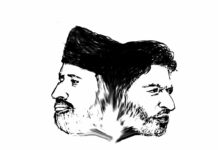
G M Lone
The Shalbaf procession is a very significant event in the history of Kashmir. It was the first ever agitation against the exploitative work system. It was on 29 April 1865 when scores of shawl weavers marched through the streets of Shehr-e-Khaas against the taxes on shawls (Dag-i-Sawl).
The Shawlbaf procession was a big event in the global context as it took place much before the historic May Day of 1886.
Dag-i-Shawl (department of shawls) was introduced by Dad Karim Khan, Afghan Governor in 1776, because of high demand of shawls in the market.
In 1776 Afghan Governor Yahya Abdullah Khan, a blind divine of Sayeed Yahya of Baghdad, paid visit to Srinagar. On his return, government presented him a Kashmiri shawl. Sayeed later visited Egypt and presented it to the Khedive (One of the Turkish viceroys who ruled Egypt between 1867 and 1914). Sometimes later when Napoleon Bonaparte visited Alaxanderia, the Khedive made a gift of Kashmiri shawl to him.
When he returned, Kashmiri shawls became immediately fashion all over the world. The woollen shawl industry provided employment to thousands of men, women and children and was a lucrative source of income to the state.
According to Major R Leech, the shawl weavers of Kashmir are more taxed than workmen. They were bound to work night and day when the proceeds of the farm threaten to fall off.
During the early part of Sikh rule, the total value of Kashmir woollen shawls manufactured in Kashmir was estimated at about Rs 35 lakh per annum. The government levied a duty of 26% on the estimated value of the shawls.
In the time of Diwan Kripa Ram, the government collected as much as Rs 12 lakh annually as the duty on shawls. From 1828 onwards, a brisk trade had been carried on between France and Kashmir, thus it became money-spinner for the government as well as to Kharkhandars. This international demand of Kashmiri shawls shot up the price of an embroidered shawl from Rs 150 to Rs 5000.
The Shawl-weavers were thus in absolute charge of the ‘Karkhandars’ they became their slaves and were forced to work very hard. Ram Dayal fixed 98 rupees as a tax per loom. The market was being only one rupee. This together the tax amounted to Rs 150 per loom. The weavers might or might not work but he had to pay. No wonder 22-Shawl weavers are said to have cut their thumbs in order to be disabled to pursue the profession of Shawl weaving and thus be saved from the tyrannies of their Karkandars.
During Gulab Singh’s rule (1846-1857) there were 27,000 weavers working at 11,000 looms but the wages paid to the workmen were miserably low. The Shawl weavers could bear the tyrannous system no longer. For once they combined and struck work on June 6, 1847. Due to Maharaja’s intervention the revolt was subdued.
Government gave Shawl industry to the Rajkak Dhar on contract; he paid to the state Rs 12 lakh. The weavers had thus to pay Rs 49 each and they were again kept under the charge of Kharkandars.
The result was that after working from morning to night a shawl weaver could get no more than four paisa in wage per day.
A weaver could use these seven or eight rupees per month as the taxation policy was 300 percent. Weaver could not pay the tax and thus became debtor to the government. The intolerable condition of weavers forced them to unite, to present him with a petition for the redress of their grievances.
Raja Dhar, however, misrepresented this and convinced the government that the precisionists would attack his house. As the protesters reached Zaldgar, the Dogra troops led by Colonel Bijoy Singh rounded off the demonstrators and asked them to disperse. When the unarmed protesters refused to do so, the troops fired at them and later charged them with spears. Scores of protesters jumped off the Haji Rather Sum Bridge at Zaldgar, in the hope they would hide in the marsh underneath, but at least 28 bodies were recovered from the river, and over 100 sustained wounds.
(Author is a teacher.)















